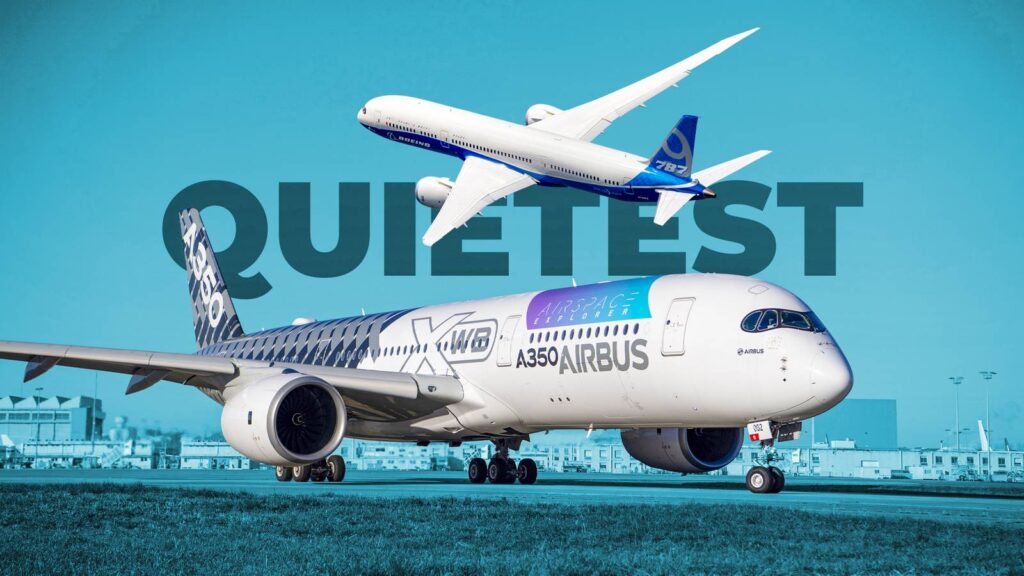
The Airbus A350 and Boeing 787 stand as two of the most recognizable widebody aircraft in modern aviation. These aircraft, celebrated for their advanced technology and passenger comfort, have become integral to the fleets of airlines worldwide. Primarily used on ultra-long-haul and long-haul routes, they are also seen on shorter routes, setting benchmarks for efficiency and reliability in the industry.
Both aircraft emphasize passenger comfort, traditionally associated with cabin design, seating, and technology. However, a less considered factor significantly impacts passenger experience: aircraft noise.
The Battle of the Widebodies
Boeing launched the 787 program in April 2004, unveiling it in July 2007, with the first delivery to All Nippon Airways in September 2011. The 787, a next-generation aircraft, promised advanced technology and maximum fuel efficiency. Composed of 50% composites, it comes in variants like the 787-8, 787-9, and 787-10, seating 250–340 passengers and offering a range of up to 7,565 nautical miles (14,010 km) for the 787-9. By mid-2025, Boeing had delivered over 1,200 airframes to various carriers, including ANA, United Airlines, and American Airlines.
Airbus followed with the A350 program in October 2005. Its prototype flew in June 2013, and the aircraft entered service with Qatar Airways in January 2015. The A350 offers variants such as the A350-900, A350-900ULR, A350-1000, and the upcoming A350-1000ULR and A350F. It accommodates 300–400 passengers, slightly more than its American counterpart, with the A350-900 boasting a range of 8,100 nautical miles (15,000 km). The A350-900 ULR can cover up to 9,700 nautical miles (17,964 km).
Both aircraft have earned reputations as reliable workhorses, beloved by crews, passengers, and airlines. They compete directly, strengthening the Airbus vs. Boeing rivalry, as each seeks marginal gains over the other.
Clever Cabin Design
Cabin design significantly influences passenger comfort and satisfaction. Elements such as seat pitch, ergonomics, lighting, air quality, and materials shape the travel experience. How do the Airbus A350 and Boeing 787 Dreamliner compare in cabin comfort and innovation?
The Boeing 787 features a low cabin altitude of around 6,000 feet and higher humidity levels than traditional aluminum fuselage aircraft. Its composite structure allows for cleaner air and larger windows, about 30% bigger than older aircraft, with electronic dimming. LED mood lighting helps reduce jet lag, and quiet engines and improved pressurization enhance comfort on long flights. While comfort depends on airline configuration, the 787 generally offers a modern, passenger-friendly atmosphere.
The Airbus A350’s “Airspace” cabin is one of the quietest and most spacious twin-aisle environments. Its wider fuselage provides extra shoulder room, wider seats, and larger aisles compared to competitors, including the 787. Like the Dreamliner, it maintains low cabin altitude and good humidity, with LED mood lighting and large, electro-dimmable windows. Advanced noise insulation and smooth airflow design make the A350 remarkably quiet, delivering a refined experience on ultra-long-haul routes.
Noise Level Comparison
Beyond cabin design, passenger comfort on long flights often emphasizes inflight meals, entertainment, and amenities. But is there more to comfort than these physical characteristics? Airbus believes so.
The Airbus A350 is one of the quietest twin-aisle aircraft. Cabin noise levels are up to 5dB lower than previous-generation widebodies, with up to 9dB less noise in forward sections. Passengers experience reduced ambient sound throughout all flight phases, creating a calm atmosphere ideal for long-haul travel. The A350’s quietness is a key factor in its premium reputation.
The Boeing 787 Dreamliner is also quieter than older aircraft and even quieter than the A350 in some conditions. Its cabin noise is roughly 20% lower than comparable previous-generation jets, reducing fatigue and improving rest. Passengers note the 787’s calm environment and softer engine sound, marking a step forward from earlier designs. While both aircraft offer a modern, quiet experience, the A350 is quieter overall.
Coincidence or Clever Design?
Airbus emphasizes passenger experience, particularly cabin noise, across its A350 variants. The cabin creates a calm, comfortable, and quiet environment. Is this a byproduct of modern technology, or a result of deliberate design focused on comfort?
Airbus optimized the aircraft’s structure to minimize vibration and sound transmission. The fuselage and wings, made from carbon-fiber-reinforced polymer, reduce weight and dampen noise more effectively than aluminum. The Rolls-Royce Trent XWB engines, with acoustic liners and advanced fan blade geometry, significantly reduce engine noise. These elements lower the sound footprint, particularly during takeoff and cruise.
Inside, Airbus focused on isolating and absorbing noise. Acoustic insulation is built into the floor, sidewalls, and ceiling panels, while air ducts and ventilation systems reduce airflow noise. The cabin layout, with softer materials and vibration-dampening fixtures, maintains a peaceful environment throughout the flight.
Looking to the Future
Future developments in cabin noise reduction may focus on adaptive technologies. Advanced composite materials could absorb or dampen vibrations, preventing sound from spreading through the fuselage. These materials could counteract specific frequencies, creating a quieter environment without adding weight.
Active noise control, similar to technology in pilot headsets, could be embedded within cabin panels. Future aircraft could generate sound waves that cancel unwanted noise in real time, maintaining low noise levels regardless of engine speed, airflow, or turbulence.
Engine innovation will also play a role. Quieter engine architectures, such as ultra-high bypass turbofans and hybrid-electric propulsion, promise to cut noise dramatically. Combined with improved airflow systems and AI-based acoustic monitoring, these technologies could make future aircraft cabins quieter and dynamically tuned for comfort.
The battle between the Boeing 787 and Airbus A350 represents the pinnacle of modern long-haul comfort, efficiency, and quiet design. Both aircraft have redefined passenger expectations through innovations like lower cabin altitude, higher humidity, and advanced soundproofing. Their competition has pushed both manufacturers to refine every aspect of the passenger experience, proving that comfort is as critical as performance and fuel efficiency.
Beyond comfort, the rivalry showcases the evolution of aviation technology and design. Boeing’s focus on composites and fuel-saving aerodynamics is matched by Airbus’s emphasis on flexibility and advanced systems. Together, they set new benchmarks for long-haul travel, influencing how airlines and passengers define quality and value in air travel.
Looking ahead, this competition will continue as Boeing and Airbus focus on the next generation of single-aisle aircraft, successors to the 737 and A320 families. These models are expected to incorporate quieter engines, lighter materials, and smarter cabin technology. As airlines demand quieter, cleaner, and more efficient aircraft, the rivalry will likely intensify, driving innovation in performance and the flying experience.






